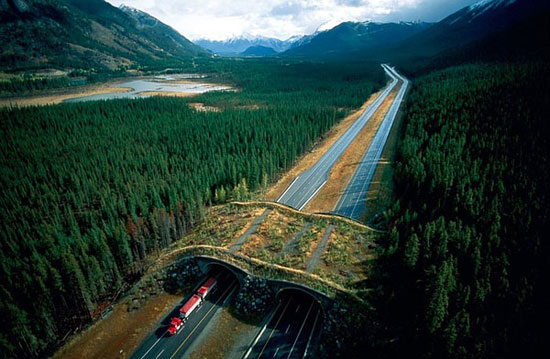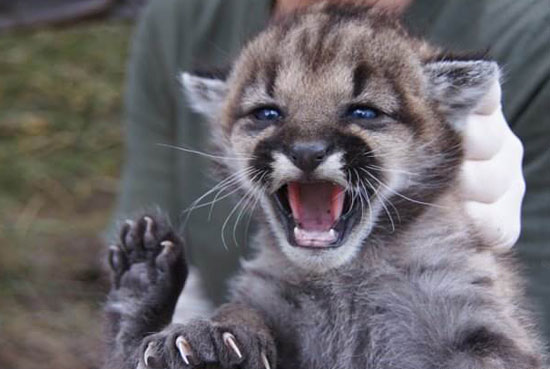
An overpass in British Columbia offers habitat linkage like that being sought here. Photo/Joel Sartore
For those on the front lines of preserving the vibrancy of wildlife in the Santa Monica Mountains, establishing a safe way for animals to get across the fast-moving 101 Freeway has been a long-held dream.
Some new developments may be pushing that vision closer to reality.
Galvanized by a series of mountain lion deaths in recent years, a multi-jurisdictional team is developing long-term strategies—including possible creation of the state’s first wildlife freeway overpass—as well as more immediate fixes to help link animals with their natural territories on either side of the 101.
Caltrans announced it has applied for a $2 million federal grant to fund environmental review and engineering design of a proposed “Liberty Canyon Wildlife Crossing” in Agoura Hills.
“US Highway 101 is an impassible barrier for wildlife migrating into or out of the Santa Monica Mountains. Animals with large home ranges, such as mountain lions, are essentially trapped within the mountain range, which can result in inbreeding and high mortality rates,” Caltrans said in announcing its grant application. “This wildlife crossing promises to provide for an improved habitat connection across a fragmented landscape, which will help sustain and improve the genetic diversity of mountain lions, deer, coyotes and other native species.”
The agency has previously applied unsuccessfully for federal funds to build a wildlife tunnel under the freeway. This time around, though, it’s seeking funding to study a range of alternatives, including the overpass. The cost and timetable of building such a structure have yet to be determined.
A decision on Caltrans’ grant application is expected before the end of the year. In the meantime, efforts are underway to jumpstart strategies that would make the crossing safer for animals even before an overpass is developed. They include:
- New and improved fencing to route animals away from the freeway and toward the existing underpass, Liberty Canyon Road.
- New vegetation around the existing underpass to also help lure animals away from the freeway and toward safety.
- Exploration of ways to enhance the wildlife-friendliness of the area, including eliminating lighting or placing it on timers.
- A commitment by the Resource Conservation District of the Santa Monica Mountains to provide architectural and landscape design services to help support the search for grant funding of the proposed new overpass.
“The idea is to have a robust crossing area,” said Clark Stevens, an architect who also serves as executive officer of the conservation district, which is working on the initiative with Caltrans, the Mountains Recreation & Conservation Authority and the office of state Senator Fran Pavley.
The stakes are high, both in the short term and over the long haul.
“What we’re interested in is making sure we continue to have a full complement of species in the Santa Monica Mountains, and that it doesn’t become an island of extinction,” Stevens said.
The overpass idea has been successfully implemented in other states, including Montana and Arizona, as well as in Canada, he said.
The proposed Liberty Canyon overpass, still in the preliminary planning stages, would be, in effect, “a piece of habitat over the freeway,” Stevens said. It could include a “guzzler” watering station for animals as well as chaparral and mature trees.
And, while animals would tend to use the crossing after-hours, humans could enjoy hiking over it during the day.
“One of the great things about it is it would allow a trail connection over the freeway that doesn’t exist anywhere else in that area,” Stevens said.
Many kinds of animals would be expected to use an overpass. But the survival and well-being of mountain lions—the Santa Monica Mountains’ “apex predator”—is particularly critical to the health of the overall ecosystem.
“Mountain lions are one of the ones that are most in need, and most in long-term danger because they exist at such low density and move over such long distances,” said Seth Riley, wildlife ecologist for the National Park Service’s Santa Monica Mountains Recreation Area. (Although mountain lions are rare in the Santa Monicas, he noted, they are common elsewhere in California and the U.S.)
Riley said scientists in the Santa Monicas currently are monitoring four adult mountain lions and two kittens via GPS-equipped collars. Another one-time resident, the male lion known as P-22, is believed to have traveled from the Santa Monicas across two freeways and into Griffith Park, where he is now at a “dead end” as far as breeding opportunities, Riley said.
By surviving that journey, P-22 is one of the lucky ones.
The current wildlife crossing efforts were galvanized by the death last October of another male mountain lion, who is believed to have made it across the 101 at Liberty Canyon, only to be forced back onto the freeway and killed after he encountered a fence he could not scale. Earlier this year, three mountain lion kittens also were killed on L.A. County roadways.
Other notable casualties include a young male lion who was shot and killed by police officers after he found his way into a courtyard in Santa Monica in 2012, and another, known as P-18, who was struck and killed by a car on the 405 Freeway near the Getty Center in 2011.
In some ways, it’s remarkable that the species has been able to survive at all in L.A.’s urban sprawl, Riley said.
“It’s an amazing thing that a large carnivore persists in Los Angeles,” he said. “If that were to be lost, that would just be a huge spiritual and aesthetic loss, I think.”

New measures aim to make life safer for even the littlest mountain lions. Photo/National Park Service
Posted 7/31/14






